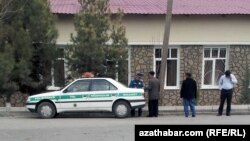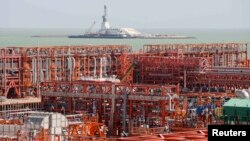
It's been difficult to know exactly what is happening inside Turkmenistan for some two decades now.
Only small snippets of information get out about the social situation and the lives of the people living there.
These bits of news from Turkmenistan are faithfully chronicled by the websites of Turkmen outside the country, but generally focus on the negative aspects of governance in the country (and there are many of those).
One young person from RFE/RL's Turkmen Service, Azatlyk, returned to Turkmenistan earlier this year after four years outside the country.
Young enough to be termed a member of the Altyn Asr ("Golden Era") generation (i.e. the supposedly "blessed" generation who came of age under the "wise leadership" of Saparmurat Niyazov following Turkmen independence in 1991), this individual recounted to Qishloq Ovozi what was different and what was the same.
Not everything there is bad it seems.
(Note: Given the nature of the Turkmen regime, Qishloq Ovozi is withholding the name of this RFE/RL colleague who still has family and friends back home)
We shall call our young Turkmen friend the "Vatanchi (Homelander)."
The customs official at Ashgabat airport had a predictable welcome for Vatanchi. "What were you doing there [in Prague]?" he "rudely" asked. Another customs official arrived and the two engaged in a brief, hushed conversation. Vatanchi was waved through.
Only four years after Vatanchi last looked upon Ashgabat, the downtown appeared different Vatanchi said the current Turkmen president's love of white marble buildings has turned central Ashgabat into a monotonous assortment of various government and commercial buildings that bear a strong resemblance to one another.
Buildings that pre-dated President Gurbanguly Berdymukhammedov, or even Turkmenistan's independence, and once broke up the long blocks of white, new buildings have been almost all razed.
Just outside the city center the buildings have fresh coats of paint but Vatanchi said there is no change to the apartment buildings inside.
Vatanchi noticed changes while walking around the capital. Some old women, Vatanchi lamented, are forced to try to sell small items -- socks, onions -- on street corners to get money, which our young Turkmen friend said is a great shame in a culture that usually holds its elders in high esteem.
There are more cars on the roads, even more luxury cars. In fact, Vatanchi noticed that more people seem to have more access to money now than they did four years ago.
Vatanchi was not convinced that was a good thing since the general poverty of nearly all had previously formed a strong bond among the people. Now, Vatanchi said, there is a small economic gap opening up between the people in Ashgabat.
The list of available goods sounded promising. Vatanchi said people were wearing Western clothes; most young people seemed to have mobile phones and the selection of food was much better.
But Vatanchi noted, "Internet connections are a problem."
Police are more visible around the city, but Vatanchi said their presence is hardly necessary.
"You can feel the presence of the security service. It's a feeling you're controlled, watched," Vatanchi said.
Restrictions on traveling within the country have eased and it is now possible to drive from one city to another without any problems. But inside the cities there is a (undeclared) curfew at 11 p.m. and the streets are empty.
Sadly, but understandably, people are politically apathetic. No one wants to talk about politics, certainly not Turkmenistan's domestic politics.
The Turkmen people are not apathetic about community concerns, however. In the past, the people addressed complaints about utilities or poor roads to the country's president to try to scare city or district officials into taking some action.
Now people tell these officials, "I will complain to Azatlyk if the problem is not solved," Vatanchi said, adding that some have traveled to neighboring Uzbekistan just to get a phone or computer connection to Azatlyk and vent their grievances.
-- Bruce Pannier
Only small snippets of information get out about the social situation and the lives of the people living there.
These bits of news from Turkmenistan are faithfully chronicled by the websites of Turkmen outside the country, but generally focus on the negative aspects of governance in the country (and there are many of those).
One young person from RFE/RL's Turkmen Service, Azatlyk, returned to Turkmenistan earlier this year after four years outside the country.
Young enough to be termed a member of the Altyn Asr ("Golden Era") generation (i.e. the supposedly "blessed" generation who came of age under the "wise leadership" of Saparmurat Niyazov following Turkmen independence in 1991), this individual recounted to Qishloq Ovozi what was different and what was the same.
Not everything there is bad it seems.
(Note: Given the nature of the Turkmen regime, Qishloq Ovozi is withholding the name of this RFE/RL colleague who still has family and friends back home)
We shall call our young Turkmen friend the "Vatanchi (Homelander)."
The customs official at Ashgabat airport had a predictable welcome for Vatanchi. "What were you doing there [in Prague]?" he "rudely" asked. Another customs official arrived and the two engaged in a brief, hushed conversation. Vatanchi was waved through.
Only four years after Vatanchi last looked upon Ashgabat, the downtown appeared different Vatanchi said the current Turkmen president's love of white marble buildings has turned central Ashgabat into a monotonous assortment of various government and commercial buildings that bear a strong resemblance to one another.
Buildings that pre-dated President Gurbanguly Berdymukhammedov, or even Turkmenistan's independence, and once broke up the long blocks of white, new buildings have been almost all razed.
Just outside the city center the buildings have fresh coats of paint but Vatanchi said there is no change to the apartment buildings inside.
Vatanchi noticed changes while walking around the capital. Some old women, Vatanchi lamented, are forced to try to sell small items -- socks, onions -- on street corners to get money, which our young Turkmen friend said is a great shame in a culture that usually holds its elders in high esteem.
There are more cars on the roads, even more luxury cars. In fact, Vatanchi noticed that more people seem to have more access to money now than they did four years ago.
Vatanchi was not convinced that was a good thing since the general poverty of nearly all had previously formed a strong bond among the people. Now, Vatanchi said, there is a small economic gap opening up between the people in Ashgabat.
The list of available goods sounded promising. Vatanchi said people were wearing Western clothes; most young people seemed to have mobile phones and the selection of food was much better.
But Vatanchi noted, "Internet connections are a problem."
Police are more visible around the city, but Vatanchi said their presence is hardly necessary.
"You can feel the presence of the security service. It's a feeling you're controlled, watched," Vatanchi said.
Restrictions on traveling within the country have eased and it is now possible to drive from one city to another without any problems. But inside the cities there is a (undeclared) curfew at 11 p.m. and the streets are empty.
Sadly, but understandably, people are politically apathetic. No one wants to talk about politics, certainly not Turkmenistan's domestic politics.
The Turkmen people are not apathetic about community concerns, however. In the past, the people addressed complaints about utilities or poor roads to the country's president to try to scare city or district officials into taking some action.
Now people tell these officials, "I will complain to Azatlyk if the problem is not solved," Vatanchi said, adding that some have traveled to neighboring Uzbekistan just to get a phone or computer connection to Azatlyk and vent their grievances.
-- Bruce Pannier







